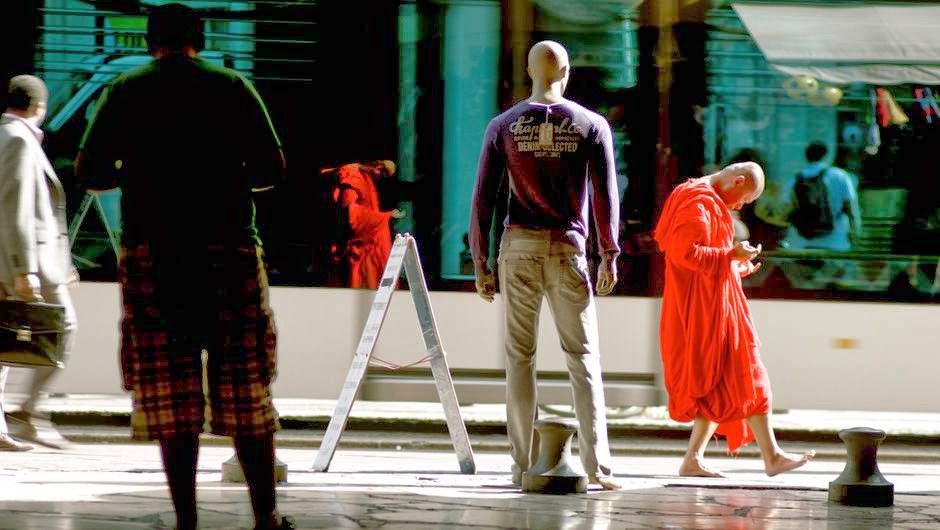Journey to the West (Tsai Ming-liang, 2014)

When I was young, in the first half of the 1980s, whenever I committed some minor childhood infraction, my punishment (this being before the adoption of the “timeout” lingo) was to stand facing a wall for some indeterminate amount of time, usually around ten minutes, which of course felt like an hour or two to my temporally expansive pre-adolescent mind. I committed a lot of infractions, so I became quite used to this, and eventually even learned to enjoy it. I’d stare at the wood-paneling (again, 1980s), count the small nail holes, follow the flow and swirl of the knots and the minute contours of the wood, the various shades of beige and brown swirling in an alien, prehistoric landscape. Forced to stare at an apparently empty, action-less space, I learned that if you look at it long enough, anything can become interesting. I learned that boredom is a state of mind, not a state of being.
Little did I know this experience was training me to watch Tsai Ming-liang films. This hour-long short, a continuation of his even shorter film Walker, observes Tsai’s muse Lee Kang-sheng as he walks, dressed as a monk in flowing red robes, through a city. In Walker he walked through Taipei, carrying a mysterious parcel through streets and crowds, finally reaching his destination, whereupon he unwrapped and took a bite out of a sandwich, made all the more delicious by the very long time it took to take it home. This time the monk is in Marseille, and there appears to be a plot and a co-star, none other than French cinema icon Denis Levant. The story is hinted at in the title and somewhat clarified in an accompanying note from Tsai:
“His walking, so special and so slow, in all the four corners of the world recalls that of Xuanzang, the holy monk of the Tang dynasty, who traveled thousands of kilometers seeking the holy scriptures. In the classical Chinese novel The Journey to the West, Xuanzang frees the Monkey King from his prison at the foot of a mountain. In Marseille, there is a rock that resembles the face of a monkey: in the bay of monkeys. Fashioned by the effects of time, Denis Levant’s face is like these rocky shapes and I am irresistibly attracted to it. That was how I started to think of Lee Kang-sheng walking on his face…”
The film opens with its longest shot, an extreme closeup of Levant’s face, lying on a diagonal, half in shadow. As Tsai forces us to stare at it at seemingly interminable length, the face becomes something else, an alien landscape of valleys and mountains and rivers and crevasses; every pore, every grey hair a story, every fold of Levant’s now 50+ year old face containing multitudes. We’ll revisit this face at the seaside, I assume at the Bay of Monkeys Tsai refers to, making literal the transformation from face to landscape.
Most of the film though chronicles the monk’s journey through the city in a series of long shots, the camera even more static than the monk. These shots inspire a fun, Where’s Waldo-esque challenge where you try to pick the monk out of the crowd (hint: he’s the thing that’s not moving). But they also seem to be allegories for Xuanzang’s journey. A pungent red wall becomes perhaps the scene of a mighty battle the monk witnesses, a long staircase a descent into the underworld. The monk begins to appear in reflections, the mirror in a man’s apartment, a glossy wall overlooking a plaza packed with travelers and people at play (a crowd gathers around a man playing the piano, another man sets adrift giant bubbles). Are the mirrors indicative of his journey to “the other side”? In one of the film’s final shots, the monk is being followed by Levant, also walking very slowly past a sidewalk cafe, following a patch of sunlight. The Monkey King, freed at last, has joined the journey.
It’s a fact about the way I watch movies, some might call it a defect, that I tend to narrativize everything I see, to try to build a story out of the images on-screen, whether any particular story is necessarily intended. Even in the most abstract of experimental films I find myself creating theories and explanations for what I’m seeing, a background and a future. I think Tsai invites this kind of theorizing, and one of my favorite films from VIFF 2013, his Stray Dogs, provides a great example of this kind of filmmaking, wherein a movie can be about any number of things and the viewer finds themselves with the choice of actively fitting all the pieces together to tell a coherent story or not, of letting it work simply as image and sound, mood and emotion. Tsai gives us hints of possible avenues to walk down, but he never tells us exactly what he thinks is going on in his movies. I choose to take the title literally and see this as an adaptation of Journey to the West, as much or maybe even more so than the similarly-titled (and just as good) Journey to the West: Conquering the Demons directed by Stephen Chow that was also released this year. The two films would make a great, if whiplash-inducing, double feature.
In the end, Tsai leaves us with this postscript, some famous lines from the Diamond Sutra, one of the Sanskrit texts translated by Xuanzang into Chinese:
All composed things are like a dream,
A phantom, a drop of dew, or a flash of lightning,
That is how to meditate on them,
That is how to observe them.
